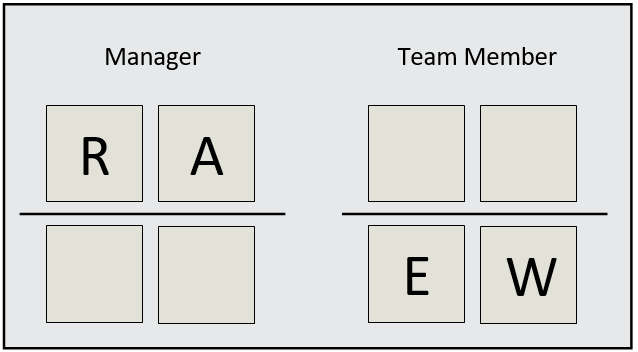A Simple Accountability Framework That Works
Strategies typically fail because of lack of clarity around accountabilities
A worrying number of strategies do not make the positive impact on organisations that they set out to achieve. In our experience, one of the key reasons for this is a lack of clarity on the accountabilities for strategy implementation. Saying ‘I’m accountable for something’ is confusing, because ‘accountable’ can mean many different things. This often leads to a fundamental mismatch between what people believe they are being asked to achieve and what a leader thinks they have made people accountable for. In other words, misalignment between the organisation’s strategy and the roles and responsibilities of its people.
Successful strategy implementation feels like a team consistently pushing a giant flywheel in the same direction. Progress is slow to start but as the organisation begins to see results, momentum builds faster and faster until eventually, its momentum works for you. With the same effort the flywheel can spin even faster, compounding the effect of the focus on strategy.
However, any misalignment between accountabilities causes friction, slowing the flywheel, or preventing it from spinning at all. You need clarity of results and accountability to ensure the flywheel can spin smoothly. You’ve probably experienced what friction feels like: things falling through the cracks, unproductive competition and manoeuvring between individuals, long waits for approvals, confusion about who does what – all those things that leave you wondering why everything seems so hard.
RAEW outlines the four key elements which combine to define the overall accountability held by a person (or team) when performing their role
To achieve alignment between strategy and people, MSH Consulting uses a remarkably simple and powerful framework called RAEW¹. This framework can be used to define accountabilities when organising teams to deliver results aligned to the strategy.
¹Source: By Dr Roger Crane, Northwestern University
However, effective accountability only has two pairings: RA (Responsibility & Authority) and EW (Experience & Work)
The best approach to allocating RAEW is to ensure that the person with responsibility also has the authority and there are always experts in the team to do the work. This is critical because assigning responsibility without authority typically sets someone up to fail. Conversely, in our experience, some managers like to enjoy the power of authority while deftly avoiding the responsibility that should go with it. To successfully complete the work, the team must also have the required expertise.
Reliable delegation of RA requires communication of specific expectations and clear limits
The RAEW model helps to simplify conversations between a manager and their team but often there are multiple layers of management between the CEO holding ‘ultimate’ RA and the EW below. This can create friction through bureaucratic chains of approvals which drag managers down into the weeds of transactional decisions. For example, a CEO with the aspiration to improve national delivery and engagement with customers might attempt to hold full RA due to fear of a lack of control and oversight as well as the risk of others making mistakes. This usually ends up working against them as it limits the autonomy of the teams carrying out the work, slows progress and distracts the leader from other strategic areas of focus. In our experience, a successful CEO would not only delegate a single manager both R (Responsibility) and A (Authority) so they can stay out of the detail, but they would delegate with clear expectations to maintain oversight of critical areas and control risks.
Setting clear expectations around the desired results and specific guidelines of limited authority ensure there are no guesses to be made about what the delegation of RA means. This clarity of understanding is then naturally cascaded down to further managers, maximising the efficiency of fast decision making and autonomy with minimal risk.
Some activities are subject to two sets of RA accountability – “Quality” and “Results”
Many modern organisations have aspects of a matrix model, where some teams focus on delivery of an outcome, while others provide expertise and implement business rules across the organisation to support delivery of that outcome. For each function to be successful, both teams must hold RA to carry out their role, however, the RA defined and communicated to both teams can intersect on particular projects or outcomes leading to confusion about who has the overall authority to decide on the path forward. To resolve these issues, it is important to understand the distinction between accountability for results and accountability for quality.
Managers accountable for quality usually sit in corporate functions such as communications, finance or IT and ensure quality through the development of frameworks, policies and standards. These are then implemented through the provision of education and support and monitoring compliance. Where the goal of the corporate managers is consistent delivery, the general managers need to focus on delivering results within the business quality rules.
Conclusion
The lack of clarity around accountabilities is a common pitfall that can undermine the successful implementation of strategies. When there is ambiguity of who is responsible for what, organisations face the risk of misalignment between an organisation’s strategy and the roles and responsibilities of its people creating friction in their flywheel. The RAEW model provides the simplicity and clarity required by defining accountabilities based on Responsibility (R), Authority (A), Expertise (E) and Work (W). Allocating R with A and E with W, organisations can ensure that everyone has what they need to successfully deliver. The advantages of the simplicity of the RAEW model is not lost in large organisations as risk can be managed through clarity of the desired results and clear boundaries when RA is delegated. Similarly, intersecting accountabilities can be distinguished through quality and results when two teams are working together to deliver a shared outcome. RAEW is a flexible and practical tool to have in the strategy implementation toolkit of any organisation to ensure the flywheel can build momentum through consistent efforts of the entire organisations pushing in the same direction.





